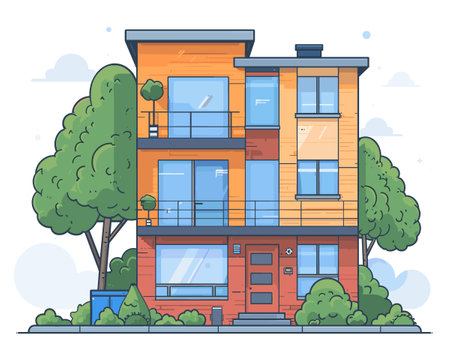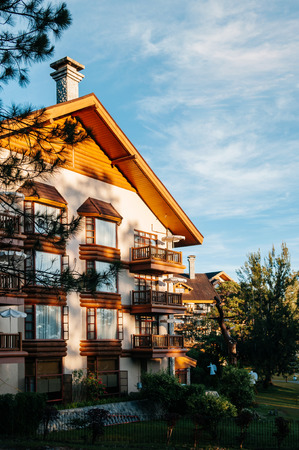1. Understanding Feng Shui Principles in the American Context
Feng Shui, an ancient Chinese practice, focuses on creating harmony between people and their environment. At its core, Feng Shui emphasizes the flow of energy—also known as “Chi”—through spaces to support well-being, happiness, and success. While rooted in Eastern philosophy, these principles have found a unique place in American homes, blending with local architecture and lifestyle preferences.
Feng Shui Fundamentals
The basics of Feng Shui revolve around balancing five natural elements: Wood, Fire, Earth, Metal, and Water. It also considers the importance of natural light, room layout, color choices, and furniture placement. In traditional Chinese settings, these aspects are carefully calibrated to ensure that Chi moves freely and positively throughout the space.
Adapting Feng Shui for American Homes
American homes come in many shapes and sizes—from mid-century modern ranches to classic Colonials and sleek urban apartments. Each architectural style presents unique opportunities and challenges for applying Feng Shui principles. The American approach often prioritizes comfort, openness, and practicality while still respecting the goal of balanced energy flow.
Common Ways Americans Adapt Feng Shui
| Traditional Feng Shui Concept | American Adaptation |
|---|---|
| Emphasis on natural elements | Use of indoor plants and sustainable materials |
| Careful room orientation | Open floor plans with intentional furniture arrangement |
| Maximizing natural light | Larger windows, skylights, and glass doors |
| Color symbolism | Modern palettes that reflect both personal taste and energy needs |
| Decluttered spaces for energy flow | Minimalist designs with functional storage solutions |
The Role of Natural Light in Feng Shui for U.S. Homes
Naturally lit spaces are highly valued in both traditional Feng Shui and modern American design. Good natural lighting is believed to boost positive energy, enhance mood, and even improve productivity—qualities that align well with contemporary lifestyles across the United States. Whether through large bay windows in a suburban home or clever skylight placements in city lofts, integrating natural light is a key way Americans interpret and apply Feng Shui principles today.
2. The Role of Natural Light in Feng Shui
Natural light is a key element in Feng Shui, especially when it comes to shaping the atmosphere and energy within American homes. In Feng Shui philosophy, sunlight is seen as a carrier of positive energy, known as “chi” or “qi.” Good natural light design can help distribute this energy evenly throughout your living spaces, supporting both physical and emotional well-being.
Why Natural Light Matters in Feng Shui
Feng Shui teaches that the balance of natural elements is essential for a harmonious home. Natural light doesnt just brighten a room—it uplifts the mood, energizes family members, and even helps plants thrive indoors. In many American homes, large windows, skylights, and open floor plans are popular choices because they maximize daylight exposure and create a welcoming environment.
Impact on Energy Flow and Mood
When sunlight enters a home, it activates the flow of chi, helping to remove stagnant energy. A well-lit space feels open and alive, while rooms that lack light can feel heavy or cramped. The placement and use of natural light in different areas also affect how people feel and interact in those spaces.
| Room | Natural Light Benefits | Feng Shui Tips |
|---|---|---|
| Living Room | Boosts social energy and comfort | Use sheer curtains to allow sunlight but avoid glare |
| Kitchen | Enhances appetite and activity levels | Keep windows clean and clutter-free to let in maximum light |
| Bedroom | Improves restfulness by balancing morning light exposure | Install adjustable blinds to control brightness for better sleep quality |
| Home Office | Increases productivity and focus during the day | Position desk near a window for natural inspiration and alertness |
The Connection Between Light and Well-Being
Adequate natural light supports mental health by regulating circadian rhythms—the body’s internal clock. This is especially important in American homes where seasons bring big changes in daylight hours. By embracing smart design choices that welcome more sunlight into daily life, homeowners can boost their mood, motivation, and overall wellness while staying true to modern Feng Shui principles.

3. Architectural Considerations: Maximizing Light in U.S. Home Design
When it comes to Feng Shui, natural light is one of the most important elements for creating a balanced and harmonious home. In the United States, architectural design trends and common home layouts play a big role in how sunlight flows through living spaces. Here’s how American homes are designed to make the most of natural light, supporting key Feng Shui principles.
Popular American Home Layouts and Sunlight Flow
Many American homes feature open floor plans, which allow sunlight from windows and doors to reach more areas of the house. This openness not only makes rooms feel larger but also helps energy (or chi) move freely, which is a fundamental goal of Feng Shui. Here’s a look at how different home layouts influence natural light:
| Home Layout | Natural Light Advantages | Feng Shui Benefits |
|---|---|---|
| Open Floor Plan | Light spreads easily across living, dining, and kitchen areas | Promotes positive energy flow; reduces dark or stagnant zones |
| Ranch-Style Home | Single-story design with many exterior walls for window placement | Allows for balanced light distribution throughout the home |
| Two-Story Traditional | Multiple levels with windows on both floors | Opportunities for vertical light flow; enhances vitality in all areas |
Window Placement Strategies in U.S. Homes
The way windows are placed can have a huge impact on both natural lighting and Feng Shui energy. In American homes, large picture windows, bay windows, and sliding glass doors are popular choices for maximizing daylight. Strategic window placement is especially important in these ways:
- South-facing windows: Bring in warm, consistent sunlight throughout the day.
- Corner windows: Allow light from multiple directions, reducing shadows and dark corners.
- Skylights: Brighten up central or upper-floor spaces that might otherwise be dim.
- Bigger glass doors: Connect indoor spaces with outdoor patios or gardens, inviting more light inside.
Design Trends That Support Natural Light and Feng Shui Goals
A number of current American design trends help homeowners optimize their spaces for sunlight—and good Feng Shui:
- Lighter paint colors: Whites and soft neutrals reflect light better than darker shades.
- Minimalist interiors: Fewer walls, less clutter, and simple furniture help light move freely around the home.
- Mirrors: Placed thoughtfully, mirrors bounce sunlight into darker spots and create a feeling of spaciousness (while following proper Feng Shui mirror placement guidelines).
- Narrow window frames: Modern designs use slim frames to allow for larger panes of glass without sacrificing style.
Quick Tips for Maximizing Light in Your American Home
- Add sheer curtains instead of heavy drapes to let more daylight in while maintaining privacy.
- If remodeling or building new, consider window placements that align with your region’s sun patterns—especially focusing on east and south exposures.
- Avoid blocking windows with bulky furniture or tall shelving units.
- If possible, include transom or clerestory windows above doors to bring extra sunlight into hallways or interior rooms.
The Connection Between Architecture and Positive Energy Flow
The right architectural decisions can make your home brighter and more welcoming—and according to Feng Shui principles, this means better energy circulation, less stress, and greater overall well-being for everyone who lives there. By understanding how natural light design works within the context of American homes, you can create a space that feels good and supports your lifestyle every day.
4. Cultural Preferences and Modern Lifestyle Integration
Natural light design in American homes is more than just a practical consideration—it’s deeply connected to cultural values and lifestyle choices. Many Americans value openness, spending time with family, and feeling connected to the outdoors. These preferences align well with Feng Shui principles, especially when it comes to how light and space are used in the home.
Openness and Light: Creating Welcoming Spaces
American homes often feature open floor plans, large windows, and sliding glass doors. This love for open, airy spaces is similar to Feng Shui’s focus on allowing energy (or “chi”) to flow freely. When natural light floods a room, it creates an uplifting atmosphere that supports positive interactions and well-being.
How Openness and Natural Light Align
| American Value | Feng Shui Practice | Natural Light Design |
|---|---|---|
| Openness | Uncluttered spaces for energy flow | Large windows, open layouts |
| Family Gatherings | Central gathering areas for harmony | Bright living rooms & kitchens |
| Connection to Nature | Bringing nature indoors (plants, views) | Sunrooms, skylights, garden views |
The Importance of Family Spaces Filled with Light
Family gatherings are at the heart of American life. In Feng Shui, common areas like living rooms and dining spaces should be bright and inviting to encourage togetherness and good energy. Using large windows or arranging furniture near natural light sources makes these areas feel more welcoming.
Connecting With Nature Indoors and Out
A strong connection to nature is important in both American culture and Feng Shui. Homeowners often choose designs that blur the line between indoor and outdoor living—like patios, decks, or even big picture windows that overlook gardens or trees. These features allow sunlight to brighten interiors while providing calming views of the outdoors, which supports relaxation and balance.
Simple Tips for Integrating Natural Light with Modern Lifestyles
- Add mirrors to reflect sunlight deeper into your home.
- Select sheer window treatments that allow plenty of daylight.
- Create cozy reading nooks or breakfast areas near sunlit windows.
- Use plants to enhance both air quality and the Feng Shui of light-filled spaces.
This approach not only honors traditional Feng Shui but also fits perfectly with modern American lifestyles that celebrate openness, family connections, and a love of nature.
5. Practical Tips: Enhancing Feng Shui with Light in Your Home
Smart Ways to Maximize Natural Light
Boosting natural light in your home is a key aspect of good feng shui and positive energy flow. Whether you own or rent, these actionable tips will help you create a bright, uplifting space that feels welcoming and balanced.
Use Mirrors Strategically
Mirrors are powerful tools in both feng shui and modern American home design. Placing mirrors across from windows or in dark corners can bounce light around the room and make spaces feel larger. Here are some easy ideas:
| Location | Mirror Placement Tip |
|---|---|
| Living Room | Hang a mirror opposite a window to reflect outdoor views and sunlight. |
| Entryway | Add a small mirror to brighten up a narrow hallway, but avoid facing it directly at the front door. |
| Bedroom | Place mirrors where they don’t reflect the bed to support restful sleep and good chi. |
Window Treatments That Welcome Light
Americans love big, bright windows, but privacy is important too. Choose window treatments that allow plenty of daylight while offering flexibility. Consider these options:
- Sheer Curtains: Let in soft, filtered light without sacrificing privacy.
- Adjustable Blinds: Control the amount of sunlight by tilting slats as needed.
- Layered Drapes: Pair heavy drapes with sheers for versatility day and night.
Clever Layouts for Maximum Sunlight
The way you arrange your furniture can influence how natural light moves through your home. Try these layout tricks:
- Avoid blocking windows with bulky furniture like couches or bookshelves.
- Create open pathways so energy (and sunlight) can circulate freely throughout each room.
- If you have limited windows, keep walls and furniture in light colors to reflect more light around the space.
Quick Reference Table: Enhancing Light for Good Feng Shui
| Tip | Why It Works | How To Apply It |
|---|---|---|
| Add mirrors opposite windows | Bounces natural light, expands space visually | Try in living rooms or dining areas with good views |
| Choose sheer curtains or adjustable blinds | Keeps rooms bright while maintaining privacy | Ideal for bedrooms and street-facing windows |
| Avoid blocking sunlight with large furniture | Keeps energy flowing smoothly, improves mood | Arrange sofas and tables away from main light sources |
| Select light wall colors and décor accents | Makes rooms feel airy and inviting even on cloudy days | Use whites, creams, pale blues, or greens for walls and rugs |
No matter the size or style of your home, these simple changes can help you enjoy all the benefits of enhanced natural light and harmonious feng shui—right here in the U.S.


